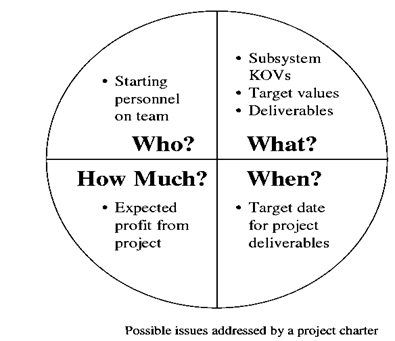Project Charter
Project Charters:
In many cases, a written “charter” constitutes the end product of the first phase of a project. The charter documents what is to be accomplished by whom and when. Figure summarizes the key issues addressed by many charters. Clarifying what can be accomplished within the project time frame with the available resources is probably the main concern in developing a charter.
- The term “scope” is commonly used in this context to formally describe what is to be done.
- The term “deliverables” refers to the outcomes associated with a project scope. Strictly speaking, “tangible” deliverables must be physical objects, not including documents. However, generally, deliverables could be as intangible as an equation or a key idea.
- Note that the creation of a charter is often a complicated, political process. Allocating the selected team for the allotted time is essentially an expensive, risky investment by management.
- Management is betting that the project deliverables will be generated and will still be worthwhile when they are delivered. The main motivation for a formal design phase is to separate the complicated and management-level decision-making from the relatively technical, detailed decision making associated with completing the remainder of the project and deliverables. Therefore, developing a charter involves establishing a semi-formal contract between management and the team about what is “in scope” and what is “out of scope” or unnecessary for the project to be successful.

- As a result of this contract, team members have some protection against new, unanticipated demands, called
- “Scope creep,” that might be added during the remaining project phases.
- Protection against scope creep can foster a nurturing environment and, hopefully, increase the chances of generating the deliverables on time and under budget.
- The project goals in the charter are often expressed in terms of targets for key output variables (KOVs).
- The principle of cost justification dictates that at least one KOV for these subsystems must have a likely relationship to bottom-line profits for the major system.
Example (Lemonade Design Scope) Because of customer complaints, an older sibling tasks a younger sibling with improving the recipe of lemonade to sell at a lemonade stand. Clarify a possible project scope including one deliverable, one target for a KOV, and oneOut-of-scope goal.
Answer: The younger sibling seeks to deliver a recipe specifying what percentage of sweetener to use (x1) with a target average taste rating (y1) increase greater than 1.5 units as measured by three family measures on a 1-10 scale.
- It is believed that taste ratings will drive sales, which will in turn drive profits. In the approved view of the younger sibling, it is not necessary that the older sibling will personally prefer the taste of the new lemonade recipe.
- In defining who is on the project team, common sense dictates that the personnel included should be representative of people who might be affected by the project results. This follows in part because affected people are likely to have the most relevant knowledge, giving the project the best chance to succeed. The phrase “not-invented-here syndrome” (NIHS) refers to the powerful human tendency to resist recommendations by outside groups. This does not include the tendency to resist orders from superiors, which constitutes insubordination, not NIHS.
- NIHS implies resistance to fully plausible ideas that are resisted purely because of their external source. By including on the team people who will be affected, we can sometimes develop the “buy-in” need to reduce the effects of the not-invented-here syndrome. Scope creep can be avoided by including all of these people on the team. In defining when a project should be completed, an important concern is to complete the project soon enough so that the deliverables are still relevant to the larger system needs.
- Many six sigma experts have suggested project timeframes between two and six months. For projects on the longer side of this range, charters often include a schedule for deliverables rendered before the final project completion. In general, the project timeframe limits imply that discipline is necessary when selecting achievable scopes.